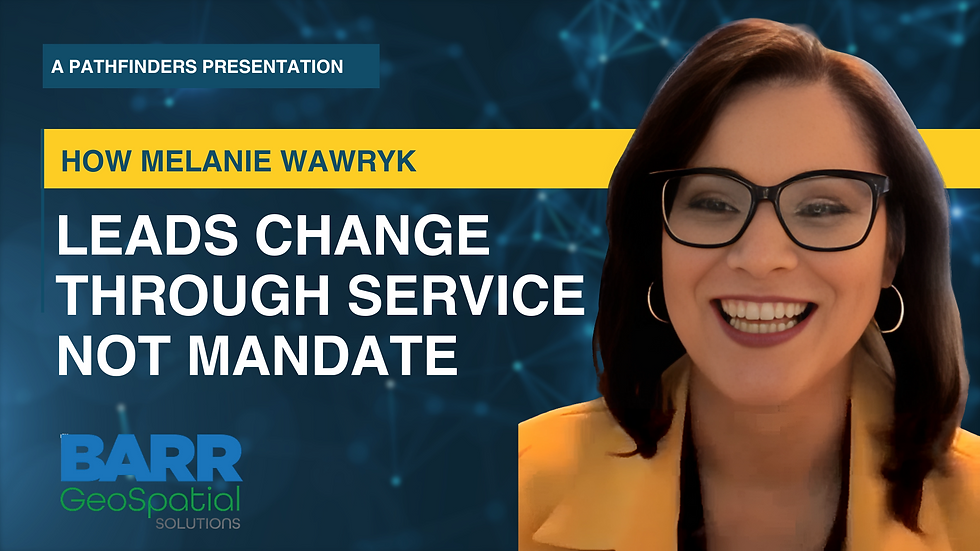Naz Ali: From Island Curiosity to Continental Impact
- Barr GeoSpatial

- Sep 1
- 4 min read
When Maps Became More Than Navigation
Growing up on a small island in Fiji, Naz Ali spent countless hours talking with visitors from Australia and New Zealand, asking endless questions about places she'd never seen. With limited opportunities to travel, maps became her window to the world—not just showing where places were, but sparking deeper questions about why communities developed where they did and how distance shaped commerce.

That childhood fascination would eventually transform how commercial real estate decisions get made across an entire continent.
Today, Naz leads location intelligence for CBRE across Canada, where her team's analysis influences millions of dollars in real estate investments. When retailers need to understand demographic patterns, when developers evaluate industrial sites, or when companies plan expansion strategies, they rely on the sophisticated geospatial platform Naz built from the ground up.
But her journey from island curiosity to continental influence wasn't direct. It required navigating language barriers, technology shifts, and the patient work of teaching non-technical professionals why location data matters more than they realised.
The Problem Hidden in Plain Sight
Commercial real estate operates on assumptions that rarely get tested. Developers choose locations based on intuition. Retailers expand into markets without understanding demographic shifts. Companies make multi-million-dollar decisions using gut feelings about "good locations."
The industry had access to unprecedented amounts of location data—census information, traffic patterns, demographic trends, competitor analysis—but lacked the expertise to transform that data into actionable insights.
"Working in commercial real estate is very visual," Naz explains. "It's all dashboards, web maps, and apps. The visualisation is key in the industry."
Traditional approaches relied on static maps and basic demographic reports.
Decision-makers received information weeks after requesting it, often too late to influence time-sensitive deals. Even when data was available, it came in formats that required technical expertise to interpret.
Naz recognised that the real challenge wasn't collecting location data—it was making complex geospatial analysis accessible to busy professionals who needed insights, not raw information.
Building Bridges Between Data and Decisions
Naz's transformation began with a crucial realisation: her role wasn't just to perform analysis, but to educate non-technical colleagues about what location intelligence could reveal. Instead of simply delivering maps and reports, she started teaching salespeople and brokers how to interpret geospatial insights.
"I teach the salespeople on a daily basis," she notes. "They're non-GIS people, so I have to teach them, especially when we're moving from paper maps to web maps."
This educational approach changed everything. Rather than positioning herself as a technical service provider, Naz became a strategic partner who helped colleagues understand how location factors influenced their clients' success.
Her breakthrough came through patient relationship-building. She'd sit with brokers, explaining not just what the data showed, but why it mattered for their specific clients. She demonstrated how demographic analysis could predict retail success, how traffic patterns affected industrial site selection, and how competitor mapping revealed market opportunities.
Over 21 years, this approach evolved into something remarkable: a coast-to-coast location intelligence platform that transforms how CBRE approaches market analysis across Canada.
From Service to Strategy
Naz's platform now supports teams across multiple provinces, providing everything from basic demographic analysis to sophisticated site selection studies. What started as simple dot-on-map exercises has evolved into complex big data analysis that influences major investment decisions.
The impact extends beyond individual transactions. Retail chains use Naz's analysis to plan national expansion strategies. Industrial developers evaluate entire regions for logistics networks. Office developers understand how transportation patterns affect tenant preferences.
Her influence reaches beyond CBRE through active involvement in professional organisations. She spent years supporting Women in GIS, helping women from different backgrounds advance their careers. She serves on program advisory committees, ensuring GIS education stays current with industry needs. She teaches part-time at BCIT, sharing practical knowledge with the next generation of geospatial professionals.
"When you are able to give to others, it just feels rewarding," Naz reflects. "It feels like you are making a difference somehow."
Your Knowledge-Bridge Pathway
For changemakers reading this, Naz's journey demonstrates how technical expertise becomes transformative when combined with patient education and relationship-building. Her story shows how specialised knowledge can influence entire industries through strategic positioning and persistent teaching.
Naz's approach reveals four key principles for technical professionals seeking broader impact:
Lead with education, not just expertise. Naz's breakthrough came when she shifted from delivering technical outputs to teaching colleagues how to think spatially about business problems.
Build relationships before building platforms. Her coast-to-coast influence emerged from years of one-on-one relationship building, not from launching impressive technology.
Make complex insights accessible to decision-makers. Success came through translating technical analysis into business insights that busy professionals could immediately apply.
Give back to grow your influence. Naz expanded her impact by actively supporting professional communities, teaching, and mentoring others in the field.
Consider these reflection questions:
What technical expertise do you possess that could influence decision-making in your industry if made more accessible?
How might you shift from providing technical services to educating colleagues about strategic applications?
What professional communities could benefit from your knowledge and experience?
How could you transform your role from service provider to strategic partner through patient relationship-building?
Ready to explore more of Naz's insights on building technical influence through education and relationship development?
Explore the full episode and discover her strategies for making complex analysis accessible to non-technical colleagues, plus practical approaches for growing professional influence through community engagement and strategic teaching.







Comments